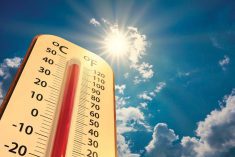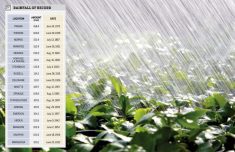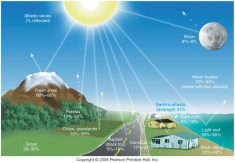It’s amazing what a little cold weather can do to people’s minds. Even after studies have come out indicating that, among active climate scientists, 97 per cent agree the current global warming we are seeing is human induced, and that these basic conclusions have been endorsed by more than 40 scientific societies and academies of science, including all of the national academies of science of the major industrialized countries, when we have a bit of local cold weather the general public in central North America is now starting to question whether global warming is real!
Read Also

June brings drought relief to western Prairies
Farmers on the Canadian Prairies saw more rain in June than they did earlier in the 2025 growing season
I don’t know how many times over the years I have pointed out “global warming” is made up of two words. Warming is rather obvious and so is global, but some people seem to think that “global” means everyone on Earth is experiencing warmer conditions at the same time. This is definitely not the case.
If there is one time of year when we’ll see bad cold snaps in a globally warmer world, I think it will be spring. We have to remember the Arctic receives no sunlight during the winter months, so even in a warm world it will still get cold during the winter in the Arctic. If we continue to see large undulations in the jet stream, this will allow warm air to push farther north than usual, but will also allow colder air to push farther south. We’ve seen exactly this over the last two years. So, even if we are seeing really cold weather, other regions of the world are seeing really warm weather. Global warming is when you add up all these cold and warm areas and end up with more warm than cold.
Most people are aware that carbon dioxide (CO2) is reported as the main culprit in global warming. While it is not the best gas for trapping heat, it stays in the atmosphere for a long time and is one of the most abundant greenhouse gases. The impression a lot of people have in their minds is that the world, as a whole, has been trying to reduce the amount of CO2 we’ve been putting in the atmosphere, so these levels should now be steady or hopefully declining. This is not the case; atmospheric CO2 continues to steadily increase.
Scientists have been tracking global levels of CO2 at the Mauna Loa observatory in Hawaii since 1958. The readings have been slowly increasing each year, starting at around 320 parts per million (ppm) in 1960 and now averaging near 393 ppm. Levels of CO2 tend to peak in late spring. On May 9, for what scientists believe is the first time in human history, the level of CO2 went above 400 ppm. It’s estimated the last time Earth has seen CO2 levels this high was about two million years ago, during the Pleistocene era, but it may have been as long ago as 10 million years ago. This is where some people say, “Well, if it was higher that long ago, then we must have nothing to do with it, because we were not around to affect the warming two million years ago!” This is absolutely true, yet there are many other natural things that can and do affect climate — such as solar input. We do know that when this increases, our planet warms, and when our planet warms, we get higher levels of CO2 that further increase the warming. However, we also know that if we artificially increase CO2, this will also cause the planet to warm.
While the 400-ppm reading was only a daily number and doesn’t indicate a recent change in global CO2 output, for most people it is seen as a significant milestone for global greenhouse gas levels. While we don’t really know what level of CO2 is “safe,” there is some consensus that if we want to maintain our current planet, 350 ppm is a goal to shoot for (check out 350.org), and we have definitely gone well beyond 350 ppm. At the current rate of increase we’ll see 450 ppm in about 20 years, or around 2035.
There are a couple of other parts to this increase in CO2 that make scientists nervous. If we look at the amount of CO2 being put into the atmosphere, overall CO2 levels should be higher. Where is this extra CO2 going? It appears the world’s oceans are absorbing it. Just how much the oceans can absorb is not really known, and we are already starting to see the effects of higher CO2 levels in the oceans because it is causing the acidity of the water to increase. This can have a direct impact on marine life, especially shellfish and corals.
The second area of concern is the speed of the increase. Over the last 55 years we have seen an increase of around 80 ppm. Looking at ice core data we find the last time we saw a rapid increase in CO2 levels was after the last ice age. At that point in time it took 7,000 years for CO2 levels to increase by 80 ppm. That means we are adding CO2 to the atmosphere at a rate more than 100 times faster than it would otherwise occur naturally. So, the question is, how well will plants and ecosystems be able to handle this rapid change? No one really knows.
In our next issue I think it’s time to start looking at summer weather… and what defines summer in Manitoba better than thunderstorms?



















